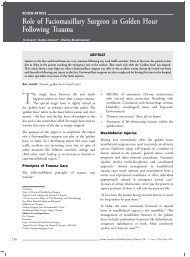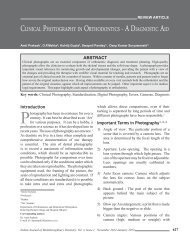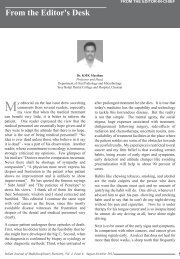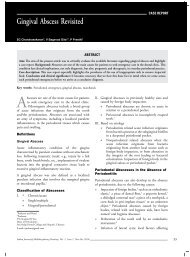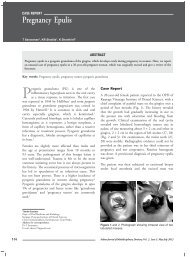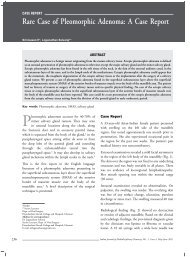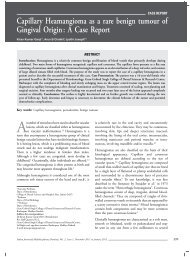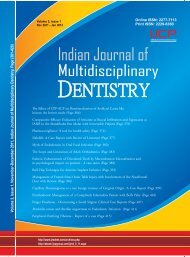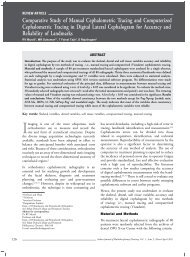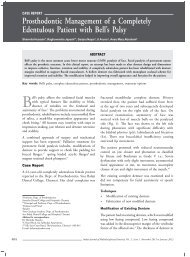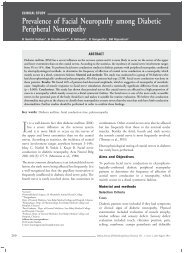Volume 2 - Issue 3 (May-Jul)
Volume 2 - Issue 3 (May-Jul)
Volume 2 - Issue 3 (May-Jul)
Create successful ePaper yourself
Turn your PDF publications into a flip-book with our unique Google optimized e-Paper software.
Role of ‘Live Microorganisms’ (Probiotics) in Prevention of<br />
Caries: Going on the Natural Way Towards Oral Health<br />
Vineet Agrawal*, Sonali Kapoor**, Nimisha Shah †<br />
*Senior Lecturer<br />
**Professor<br />
Dept. of Conservative and Endodontics, MP Dental College and Oral<br />
Research Institute, Vadodara<br />
†<br />
Professor, Dept. of Conservative and Endodontics, KM Shah Dental<br />
College, Vadodara<br />
Address for correspondence<br />
Dr Vineet Agrawal<br />
E-mail: vineetdent@yahoo.co.in<br />
Abstract<br />
Science is providing us the tools to diagnose and treat an infection before it causes damage. For some decades now, bacteria<br />
known as probiotics have been added to various foods because of their beneficial effects for human health. Very encouraging<br />
studies have come up in recent past exploring probiotics in fields of caries, periodontal diseases and few other areas and the<br />
results tend to suggest beneficial effects of probiotics on oral health and on whole body in general. The application of probiotic<br />
strategies may, in near future, provide an end to many infections occurring in oral cavity. This article reviews the probiotic<br />
approaches, such as genetically modified Streptococcus mutans and targeted antimicrobials in the prevention of caries and<br />
discuss its future directions.<br />
Key words: Probiotics, dental caries, prevention, Bifidobacterium, Lactobacillus<br />
W<br />
D Miller first described dental caries as a<br />
bacterially-mediated process more than<br />
100 years ago. 1 Today, we know that dental<br />
caries is a multifaceted disease process. Several models<br />
have been put forward describing mechanism of caries<br />
formation. One of the earlier models that is familiar<br />
to most dentists was put forth by Fitzgerald and<br />
Keyes. 2 They used three overlapping circles describing<br />
the host, bacteria and nutrients required to foment<br />
the production of organic acids and the subsequent<br />
demineralization activity. The beauty of this model is<br />
that all three elements must be present for the disease<br />
to progress. Since all three are required for disease<br />
initiation and progression, removal of any one element<br />
ostensibly leads to the interception of the disease<br />
process.<br />
The surgical approach has been the predominate<br />
mode of caries management for the past 150 years.<br />
Dentistry has, however, in recent years moved<br />
toward an antibiotic/antimicrobial model of disease<br />
management. This approach, however, raises serious<br />
questions: 1) Do the antibiotic/antimicrobial agents<br />
Review article<br />
(chlorhexidine, povidone-iodine, fluoride, etc.) kill<br />
all offending organisms?; 2) if so, do the agents<br />
preclude the re-entry of the same organisms from<br />
external sources? and 3) if the agents do kill all the<br />
offending organisms, do any remaining pathogenic<br />
organisms have selective advantage in repopulating the<br />
tooth surfaces? To overcome the problems inherent<br />
in an antibiotic/antimicrobial approach, probiotic<br />
methods are currently under study as means of caries<br />
management.<br />
What are Probiotics, Prebiotics and<br />
Synbiotics<br />
The term ‘probiotic’ is derived from the Latin preposition<br />
pro (‘for’) and the Greek adjective (biotic), the latter<br />
deriving from the noun (bios, ‘life’). 3 It was first used<br />
by Lilly and Stillwell in 1965 to describe “substances<br />
secreted by one microorganism, which stimulates the<br />
growth of another” and thus was contrasted with the<br />
term antibiotic. 4 Today, two main definitions are used.<br />
According to a WHO/FAO report (2002), probiotics<br />
are “live microorganisms which, when administered in<br />
adequate amounts, confer a health benefit on the host”.<br />
International Life Science Institute (ILSI) Europe<br />
suggests a definition according to which a probiotic is<br />
“a live microbial food ingredient that, when ingested<br />
in sufficient quantities, exerts health benefits on the<br />
consumer”. Probiotics are microorganisms, basically<br />
bacteria, that when ingested would confer health<br />
benefit beyond the basic nutrition. 5<br />
Indian Journal of Multidisciplinary Dentistry, Vol. 2, <strong>Issue</strong> 3, <strong>May</strong>-<strong>Jul</strong>y 2012<br />
491



